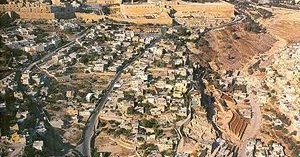Archaeologist Eilat Mazar claims to have discovered the Palace of King David. Other archaeologists acknowledge that she has uncovered a major public building from around the 10th century BCE, but are skeptical that this is the palace of David. Also found were pottery shards from the time of David and Solomon, and a government seal of Jerucal ben Shelemiah, an official in King Zedekiah’s government mentioned in the book of Jeremiah.
“King David’s Palace Is Found, Archaeologist Says,” New York Times, August 5, 2005.
“Shards of evidence,”Jerusalem Post, August 11, 2005.
‘Now, the Stones Will Speak,’ The Jewish Exponent, August 11, 2005.
In July 2008, Eilat Mazar announced that she had uncovered a seal impression (bulla) with the name of Gedalyahu ben Pashur, another one of King Zedekiah’s ministers mentioned in the Book of Jeremiah. The bulla was found only meters away from the Jerucal ben Shelemiah seal.
Scholars agree that David’s palace could only have stood on the summit of the hill occupying the site previously fortified by the Jebusites. The Bible gives no details of the style of building used but we do know that the materials used in its construction, dressed building stones and cedar wood, were not in common use. No architectural remains firmly attributable to the palace have been found, but a number of fragments that would appear to derive from such a source have been discovered. The most notable of these is a capital of the proto-Aeolic type (thought to be developing towards the Greek Aeolic form), found in the excavations of Dame Kathleen Kenyon, the British archaeologist who excavated in the City of David from 1961 to 1967. The capital was found near Area G of Shiloh’s excavations. Thirty-four such capitals have been found elsewhere in Israel at sites such as Dan, Ramat Rahel and Megiddo. As here in the City of David, none were found in situ, but all were discovered in the vicinity of large public buildings or palaces.
Also near Shiloh’s Area G, Kenyon found ashlars, square blocks of hewn stone possibly cut by Phoenician craftsmen, similar to those found by Shiloh himself, on the edge of this excavation area. In addition, a casemate wall, that is, a wall into which square compartments were built, dated to the tenth century BC, were found in Kenyon’s Area H. These elements have all been incorporated into the reconstruction of David’s palace. Proto-Aeolic capitals were used for the entrances and courtyard. Ashlars are the basic building blocks and the casemate wall protected the palace from the north.
It is conjectured that the tent for the Ark was to the west of the palace where there would have been sufficient space for large gatherings. There can rarely have been such a joyful occasion as the bringing up of the Ark into Jerusalem. Two whole chapters of the first book of Chronicles (15 and 16) are devoted to its description. This time the Ark was carried by the staves on the shoulders of the Levites, as David said, “For because ye did it not at the first, the Lord our God made a breach upon us, for that we sought him not after the due order” (1 Chron. 15.13). The musical instruments that accompanied the singing Levites are carefully enumerated and so is the fact that the elders of Israel and the military captains were part of the procession. In fact, the record describes “all Israel” (1 Chron. 15.28) as involved in the ceremony. However, it is the picture of David’s utter joy as expressed in his dancing that stands out in this account (also 2 Sam. 6.14-15). The Ark had now arrived at its last station before its installation in the Holy of Holies of the Temple built by Solomon, David’s son.
Leen and Kathleen Ritmeyer. From Sinai to Jerusalem- The Wanderings of the Holy Ark. Carta, Jerusalem, 2000. pp.56-57.
See also:
- Stone Stepped Structure, 12th century BCE
- The City of David
- Babylonian Destruction- Eilat Mazar on the burning of Jerusalem and the stamp of a biblical scribe, NOVA.
- King David, 1005-965 BCE
- Excavate King David’s Palace! Eilat Mazar, BAR 23-01, Jan-Feb 1997.
- The Mistress of Stratigraphy Had Clay Feet, Hershel Shanks, BAR 29-03, May-Jun 2003.
- Did I Find King David’s Palace? Eilat Mazar, BAR 32-01, Jan-Feb 2006.
 The City of David, where the oldest remains of Jerusalem were uncovered. Photo courtesy of Ornit Ilan. Image and Artifact- Treasures of the Rockefeller Museum with Aerial Photographs by Duby Tal and Moni Haramati. The Jerusalem Museum, 2000. p. 99.
The City of David, where the oldest remains of Jerusalem were uncovered. Photo courtesy of Ornit Ilan. Image and Artifact- Treasures of the Rockefeller Museum with Aerial Photographs by Duby Tal and Moni Haramati. The Jerusalem Museum, 2000. p. 99.




